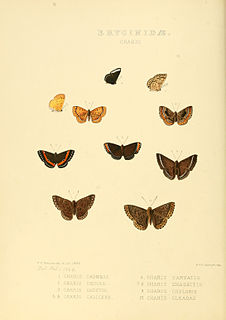
The japygids are a taxon of hexapods, of the order Diplura, commonly known as forcepstails.

Hard Love is an award-winning young adult novel written by author Ellen Wittlinger. It was published in 1999.
Seryda is a genus of moths of the family Zygaenidae.

Asterope markii, the dotted glory, is a species of butterfly of the family Nymphalidae. It is found in Brazil, Ecuador, Colombia, Peru, Guyana, and Venezuela.
Heterojapyx is a genus of diplurans in the family Japygidae.

Stenophylla is a genus of praying mantis in the subfamily Stenophyllinae, which is now placed in the family Acanthopidae. It the sole genus of the tribe Stenophyllini.
Acatinga is a genus of beetles in the family Cerambycidae, containing the following species:
Eupromerella is a genus of beetles in the family Cerambycidae, containing the following species:
Acatinga gallardi is a species of beetle in the family Cerambycidae. It was described by Penaherrera-Leiva and Tavakilian in 2004.
Cloacina is a genus of parasitic nematodes in the family Chabertiidae. Species are parasites of marsupials in Australia.

Charis is a genus of the Riodinini tribe of metalmark butterflies. Nineteen species have been identified within the Charis cleonus complex and eight species within the Charis gynaea group (clade). Charis butterflies are common in the Neotropics and often live in primary and secondary growth. The Charis cleonus group exhibits contemporary parapatric distributions throughout Amazonia and are thought to have speciated allopatrically; residing in "areas of endemism". Some evidence suggests that Charis are reproductively isolated by mating preferences for different topographic areas and different times—of which, may have promoted speciation between the various groups.




